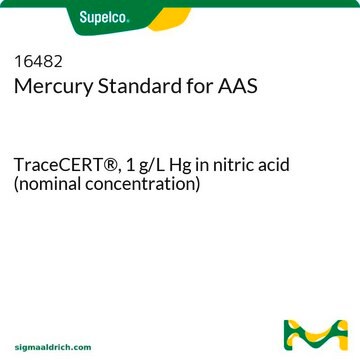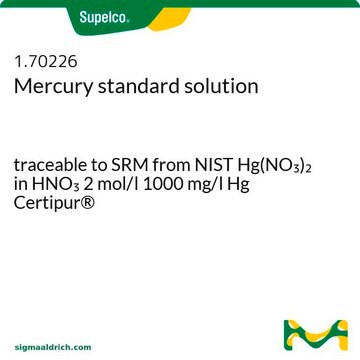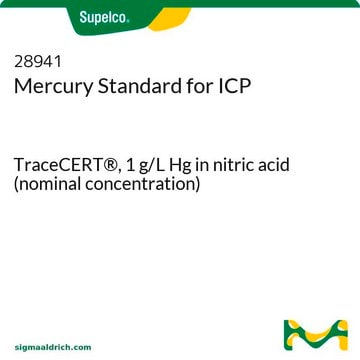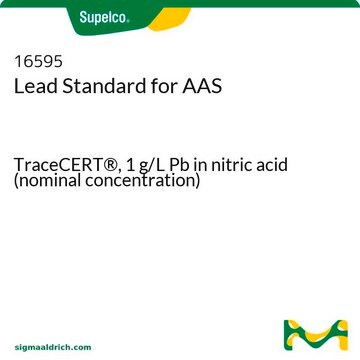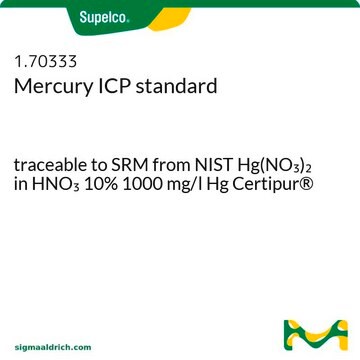19-1870
Mercury standard solution
suitable for atomic absorption spectrometry, 1 mg/mL Hg, 1000 ppm Hg
Synonym(s):
Mercury(II) chloride solution
Sign Into View Organizational & Contract Pricing
All Photos(1)
About This Item
form:
liquid
Recommended Products
form
liquid
availability
available only in Japan
concentration
1 mg/mL Hg
1000 ppm Hg
suitability
suitable for atomic absorption spectrometry
SMILES string
[Hg]
InChI
1S/Hg
InChI key
QSHDDOUJBYECFT-UHFFFAOYSA-N
Looking for similar products? Visit Product Comparison Guide
Disclaimer
For U.S. Customers: Contains mercury; Do not place in trash - dispose according to local, state, or federal laws.


signalword
Warning
hcodes
Hazard Classifications
Aquatic Chronic 3 - Met. Corr. 1
Storage Class
8B - Non-combustible corrosive hazardous materials
wgk_germany
WGK 3
flash_point_f
Not applicable
flash_point_c
Not applicable
ppe
Faceshields, Gloves, Goggles, type ABEK (EN14387) respirator filter
Choose from one of the most recent versions:
Already Own This Product?
Find documentation for the products that you have recently purchased in the Document Library.
Dileep Kumar et al.
Pharmaceutical biology, 51(4), 441-446 (2013-01-23)
Pomegranate [Punica granatum L. (Lythraceae)] is rich in antioxidants. The present work was undertaken to evaluate the protective effects of methanol extract of pomegranate peel extract (PPE) against a rat model of oxidative stress generated by treatment with mercuric chloride
Sai Jin Xiao et al.
The journal of physical chemistry. B, 116(32), 9565-9569 (2012-07-25)
Though rapid tests were developed for mass screening of prion diseases in the last century, bovine spongiform encephalopathy (BSE) was still epidemic in some European countries. The main reason is that the sensitivity of such tests is insufficient for detecting
Liakot A Khan et al.
Nature cell biology, 15(2), 143-156 (2013-01-22)
Many unicellular tubes such as capillaries form lumens intracellularly, a process that is not well understood. Here we show that the cortical membrane organizer ERM-1 is required to expand the intracellular apical/lumenal membrane and its actin undercoat during single-cell Caenorhabditis
Neelam Yadav et al.
The Indian journal of medical research, 136(2), 211-220 (2012-09-11)
Acute tubular necrosis (ATN) caused by renal ischaemia, renal hypo-perfusion, or nephrotoxic substances is the most common form of acute kidney injury (AKI). There are a few treatment options for this life-threatening disease and the mortality rate exceeds 50 per
Andrés Cruz Hernández et al.
Metallomics : integrated biometal science, 5(4), 398-403 (2013-03-27)
RNA processing is an essential pathway in the regulation of genetic expression in the cell. In this work, Bacillus subtilis was used to understand the effects of mercury on the mechanism of tRNA metabolism. The CVAAS (cold vapor atomic absorption
Our team of scientists has experience in all areas of research including Life Science, Material Science, Chemical Synthesis, Chromatography, Analytical and many others.
Contact Technical Service